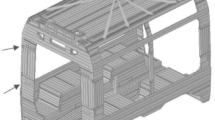Abstract
In this paper, a theoretical approach is suggested for predicting the structural performances and weight reduction rate of a car body with a box-type section when its material is substituted with a lightweight material for weight saving. For the material substitution design of a car body for rolling stock, bending, axial, and twisting deformations should be considered at constant stiffness and strength conditions. To compare the weight reduction effects on different material applications, some new indices were derived from a structural performance point of view. The derived indices provide good measures to estimate weight reduction by material substitution design and can be effectively applied to the conceptual design of a car body.
Similar content being viewed by others
References
Ashby, M. F. (1999). Materials Selection in Mechanical Design. Butterworth-Heinemann. Oxford.
Ashby, M. F. (2000). Multi-objective optimisation in material design and selection. ACTA Materialia Millenium, 48, 359–369.
Brocker, W. and Rosenberger, R. D. (1997). Light weight potentials in coach body structures of high-speed trains. WCRR, D, 713–721.
Choi, S. H., Kim, S. R., Park, J. and Young, H. S. (2007). Multi-objective optimization of the inner reinforcement for a vehicle’s hood considering static stiffness and natural frequency. Int. J. Automotive Technology 8,3, 337–342.
Chun, D. M., Ahn, S. H. and Jang, J. D. (2006). Construction of web-based material database and case study of material selection for automotive engine pulley. Trans. Korean Society of Automotive Engineer 14,4, 107–114.
Koo, J. S. and Cho, H. J. (2007). Weight-reduction prediction for the conceptual design of carbody with shell type sections using the material substitution technique. Trans. Korean Society of Automotive Engineer 15,4, 17–26.
Lewis, G. (1990). Selection of Engineering Materials. Prentice Hall. USA.
Sirisalee, P., Ashby, M. F., Parks G. T. and Clarkson, P. J. (2004). Multi-criteria material selection in engineering design. Advanced Engineering Materials, 6, 84–92.
Suzuki, T., Sato, K. and Akutsu, K. (1993). Weight reduction of a railway car body shell by applying new material. Proc. Int. Conf. Speed-up Technology for Railway and Maglev Vehicles, 1, 65–72, Japan.
Swan, D., Nev, C. and Carruthers, J. (1994). Affordable Rail Vehicles. Bodyshells Seminar of Advanced Railway Research Center. UK.
Tagawa, N., Yamashiro, H. and Kadota, K. (1993). Development of new carbody structure for high speed train. Proc. Int. Conf. Speed-up Technology for Railway and Maglev Vehicles, 1, 477–481, Japan.
Tse, F. S., Morse, I. E. and Hinkle, R. T. (1986). Mechanical Vibrations. Allyn Bacon Inc. USA.
Author information
Authors and Affiliations
Corresponding author
Rights and permissions
About this article
Cite this article
Koo, J.S., Cho, H.J. Theoretical method for predicting the weight reduction rate of a box-type car body for rolling stock by material substitution design. Int.J Automot. Technol. 10, 355–363 (2009). https://doi.org/10.1007/s12239-009-0041-1
Received:
Revised:
Published:
Issue Date:
DOI: https://doi.org/10.1007/s12239-009-0041-1




